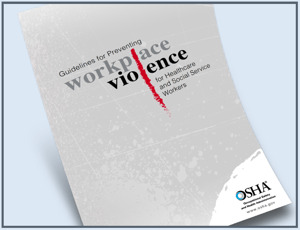Introduction
Workplace violence in healthcare settings is a critical issue, with healthcare workers being five times more likely to experience violence than workers in other industries. This alarming reality has driven accrediting bodies, state legislatures, and OSHA to prioritize workplace violence prevention.
This report aims to provide healthcare leaders with the essential information to meet the training and education requirements of a workplace violence prevention program. You will learn the:
- healthcare organization accreditation requirements
- federal and state requirements that govern workplace violence prevention
- six key attributes of an effective program
Accreditation Requirements
All major accrediting bodies prioritize workplace safety, including:
The Joint Commission’s new and revised workplace violence prevention standards, which went into effect on January 1, 2022, are the most detailed. These standards are available for review at this link:
WORKPLACE VIOLENCE PREVENTION STANDARDS - THE JOINT COMMISSION
They provide a framework to guide hospitals in developing effective workplace violence prevention systems, including leadership oversight, policies and procedures, reporting systems, data collection and analysis, post-incident strategies, training, and education to decrease workplace violence.
The Joint Commission defines workplace violence as “An act or threat occurring at the workplace that can include any of the following: verbal, nonverbal, written, or physical aggression; threatening, intimidating, harassing, or humiliating words or actions; bullying; sabotage; sexual harassment; physical assaults, or other behaviors of concern involving staff, licensed practitioners, patients, or visitors.”
Their standards specific to a workplace violence training and education program are as follows:
Standard EC.02.01.01: The hospital manages safety and security risks.
EP 17 - Rationale: With best practices and applicable laws and regulations constantly evolving, hospitals must also review the program’s policies and procedures, training, and education for consistency with the latest recommendations.
Standard HR.01.05.03: Staff participate in ongoing education and training.
EP 29 - Requirement: As part of its workplace violence prevention program, the hospital provides training, education, and resources (at time of hire, annually, and whenever changes occur regarding the workplace violence prevention program) to leadership, staff, and licensed practitioners. The hospital determines what aspects of training are appropriate for individuals based on their roles and responsibilities. The training, education, and resources address prevention, recognition, response, and reporting of workplace violence as follows:
- What constitutes workplace violence
- Education on the roles and responsibilities of leadership, clinical staff, security personnel, and external law enforcement
- Training in de-escalation, nonphysical intervention skills, physical intervention techniques, and response to emergency incidents
- The reporting process for workplace violence incidents
EP 29 - Rationale: Recognition of what constitutes workplace violence begins with awareness of the different types of physical and nonphysical acts and threats of workplace violence. Additionally, education and training should focus on de-escalation and intervention techniques when confronted with incidents of workplace violence. Incorporating violence prevention tools and encouraging the use of a simple and accessible reporting process can ultimately reduce the likelihood of healthcare staff being victims of workplace violence.
Like all healthcare accreditors, The Joint Commission provides a framework of requirements. However, it leaves it to individual organizations to determine their own policies, procedures, and practices rather than prescribing specific action steps. Regarding training and education, The Joint Commission wants the organization to decide what training each staff member will receive based on their respective roles and responsibilities.
This approach allows for flexibility and ensures that each organization’s workplace violence prevention program is perfectly suited to its specific needs and circumstances.
Legal Requirements
Now, let’s explore the federal and state legal requirements that govern workplace violence prevention training and education in healthcare settings.
At the federal level, the Occupational Safety and Health Administration is the primary agency responsible for ensuring workplace safety, including the prevention of workplace violence. Although OSHA does not have a specific standard dedicated to workplace violence, it provides essential guidelines under the General Duty Clause of the Occupational Safety and Health Act. This clause requires employers to maintain a workplace that is free from recognized hazards likely to cause death or serious harm. You can review the General Duty Clause at this link:
Recognizing that healthcare workers are particularly vulnerable to workplace violence, OSHA has issued targeted guidelines for healthcare organizations. These guidelines strongly encourage the development of comprehensive workplace violence prevention programs that include thorough training and education for all staff members. You can view these guidelines at this link:

Beyond these guidelines and the General Duty Clause, OSHA will likely propose a new rule soon, which could take effect in 2025. This rule could require healthcare employers to take a programmatic, performance-based approach to addressing workplace violence.
You can review the proposed rule titled “Prevention of Workplace Violence in Healthcare and Social Assistance” at this link:
PREVENTION OF WORKPLACE VIOLENCE IN HEALTHCARE AND SOCIAL ASSISTANCE
At the state level, workplace violence prevention laws vary widely. Some states have taken a proactive approach by enacting specific legislation mandating workplace violence prevention programs in healthcare settings.
For instance, California’s Workplace Violence Prevention in Health Care law (Cal/OSHA Section 3342) requires healthcare facilities to implement a detailed workplace violence prevention plan that includes mandatory training and education.
Other states recognize the importance of such measures and are adopting similar laws. As this trend continues, it’s crucial for healthcare organizations to stay informed about the legal requirements in their respective states.
The article at the following link provides a good overview of the workplace violence prevention state laws.
WORKPLACE VIOLENCE PREVENTION - STATE LAWS OVERVIEW
In addition to staying informed about your state’s legal requirements, healthcare organizations should be aware of the possible passing of a federal law titled “Safety from Violence for Healthcare Employees (SAVE) Act - H.R. 2584.”
This law aims to provide nationwide protections for healthcare workers against violence, which includes creating criminal penalties and enforcement mechanisms for incidents of workplace violence in healthcare settings.
The proposed text of this law is available to review at this link:
H.R. 2854 - SAFETY FROM VIOLENCE FOR HEALTHCARE EMPLOYEES (SAVE) ACT
The article at the following link provides a good overview of the status of this law as of August of 2024.
Six Key Attributes
Now, let’s explore the federal and state legal requirements that govern workplace violence prevention training and education in healthcare settings.
Attribute #1: Is Compliant With Accreditation and Legal Requirements
First and foremost, the program must meet the workplace safety accreditation and legal requirements relevant to your organization. It’s crucial to select or develop a program specifically designed to comply with these healthcare-specific standards. Avoid using generic programs that claim to be suitable for any industry, even if they have a healthcare label added to their title.
The healthcare industry is unique in many critical ways, and these nuances require a tailored approach. Therefore, your workplace violence prevention training and education program must address the unique challenges and risks present in healthcare environments. A targeted, industry-specific program will ensure that your staff is well-prepared to handle the complexities of workplace violence in a healthcare setting and that your organization fully meets the accreditation and legal requirements.
Attribute #2: Emphasis on Conflict Prevention
Second, the program must strongly emphasize conflict prevention. At Vistelar, we refer to this as non-escalation and highlight its importance through our 6 C’s of Conflict Management framework.

This framework provides a means to analyze interactions and determine which conflict management method to use given the circumstances.
Vistelar teaches specific methods for each phase of an interaction, but our primary focus is on non-escalation. These methods are designed to keep people in the blue zone of the 6 C’s framework.
The ultimate goal of this attribute is to create environments that are incompatible with emotional and physical violence.
Attribute #3: Addresses the Entire Spectrum of Human Conflict
The third attribute of an effective workplace violence prevention training and education program is that it addresses the entire spectrum of human conflict.
Here, conflict is defined as the escalation of human interactions that could lead to emotional or physical harm.
Note that disagreement is not included in this definition. Disagreement is necessary and healthy for a well-functioning organization. Also, note that well-managed conflict can have positive outcomes, such as innovation and the development of new skills, so this type of conflict should not be diminished. Instead, a workplace violence program must focus on conflict that can lead to emotional or physical harm.
Such conflict can manifest in various forms, as defined by the Centers for Disease Control and Prevention:
- Client-on-Worker Violence
- Worker-on-Worker Violence
- Criminal Intent Violence
- Personal Relationship Violence
You can access the CDC’s definition of each type at this link:
TYPES OF WORKPLACE VIOLENCE - CENTERS FOR DISEASE CONTROL AND PREVENTION
An effective workplace violence prevention training and education program must address all four types of violence. Furthermore, it should cover both verbal and physical violence. In other words, there should be no gaps in the training program. The entire spectrum of human conflict – from simple verbal disputes to physical violence – must be comprehensively covered.
Attribute #4: Uses a Risk Tier Approach to Training
The fourth essential attribute is that the training and education program must enable different people within the organization to receive training based on their risk level.
In other words, the program should not consist of just one primary training class for everyone. Instead, it should support targeted training that matches the risk level associated with each role.

For example, low-risk workers might only require training in non-escalation and de-escalation. In contrast, high-risk workers, such as security professionals, will likely need more comprehensive training that includes how to physically intervene in a violent incident.
At Vistelar, we call this a “risk-tier” approach to training. This approach aligns with the Joint Commission’s standard that organizations must “determine what aspects of training are appropriate for individuals based on their roles and responsibilities.”
In our experience, healthcare organizations generally have five distinct risk tiers. The first tier includes staff with no or minimal patient contact. The second tier includes patient care providers. The third tier includes higher-risk patient care providers, such as those working in emergency departments or behavioral health. The fourth tier includes crisis response team members. And finally, the fifth tier consists of security professionals.
An effective workplace violence prevention training and education program must have classes tailored for each of these risk tiers to address the specific needs of each staff member and meet the relevant healthcare accreditation requirements.
Attribute #5: Curricula Shares Common Principles, Methods, and Terminology
The fifth attribute of an effective workplace violence prevention training and education program is that all curricula must share common principles, methods, and terminology, with a strong emphasis on universal application and simplicity.
In other words, what is taught must be easy to learn, remember, apply, and teach.
What you don’t want are individual training classes that exist in isolation from one another. Instead, the training for each risk tier should build upon the previous tier, creating a cohesive learning experience.
At Vistelar, we call this interconnected training approach the Unified Conflict Management System, which includes a systemized structure of methods represented by these framework graphics.

All of these training programs share common principles, methods, and terminology to ensure consistency and alignment across all levels of training.
Attribute #6: Enables Courseware to be Customized
The sixth essential attribute is customizable courseware. The courseware for each risk tier shouldn’t feel like a generic, cookie-cutter program developed by a third party. Instead, regardless of who developed the training, the organization must view the program as its own.
For an organization to truly view a training program as its own, the courseware must be branded with the organization’s logo and colors and include organization-specific content, such as the organization’s mission, values, policies, and established training elements.
Additionally, any training provided as an online on-demand course should be integrated into the organization’s learning management system and accessed from there, rather than requiring employees to log in to a third-party system.
This attribute is particularly important in California, where the Workplace Violence Prevention in Health Care law requires organizations to actively involve employees in developing training curricula and materials, participating in training sessions, and reviewing and revising the training program.
You can review a fact sheet about this law at this link:
WORKPLACE VIOLENCE PREVENTION IN HEALTH CARE - CAL/OSHA FACT SHEET
You can review the actual law at this link:
DEPARTMENT OF INDUSTRIAL RELATIONS § 3342. VIOLENCE PREVENTION IN HEALTH CARE
As another component of being customizable, the training and education program – if supplied by a third-party vendor – should not have these restrictions:
- Prohibiting deviations from the vendor’s defined lesson plan
- Requiring the purchase of vendor-supplied courseware in its cookie-cutter form for each student within the organization
- Restricting the incorporation of training content into other training modalities, such as virtual classes of different lengths or online on-demand courses
- Limiting the development of organizational instructors to those trained by the vendor, with mandatory periodic recertification.
One example of what can occur without these restrictions is delivering training during shift reports in six-minute increments. Having such training at every shift change results in staff receiving an additional 24 hours (three whole days!) of learning each year. One Vistelar client was so enamored with this approach that they coined “Six for Safety,” which everyone in their organization now uses to describe this incremental opportunity to review and practice their conflict management skills.
The end goal of this customizable courseware attribute is for the training and education program to meet the specific needs of the organization rather than seeming like an off-the-shelf solution.
Summary
In summary, an effective workplace violence prevention training and education program must meet accreditation and legal requirements, emphasize conflict prevention, address the entire spectrum of human conflict, enable a risk-tier approach, share common principles, methods, and terminology across all curricula, and offer customizable courseware that aligns with your organization’s unique needs.
By focusing on these six essential attributes, you can create a safer, more cohesive work environment in which your team is well-prepared to prevent and manage workplace violence.

Who is Vistelar
This report was written by Vistelar, a conflict management training institute focused on building safe and respectful workplaces. Vistelar has over four decades of real-world experience in workplace violence and has published six books on conflict management.
Our goal is for our customers to achieve these benefits from working with us:
![]()
Learn More About Vistelar
So we can provide the best information, please let us know the problems you face with your existing workplace violence prevention training and education program.


.png?width=102&height=95&name=Accreditation%20Commission%20for%20Health%20Care%20(ACHC).png)

